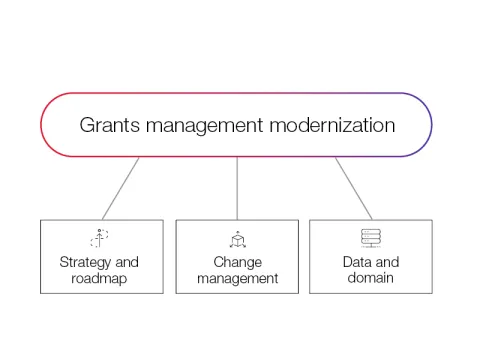Federal agencies issue hundreds of billions of dollars in grants each year for programs and projects that benefit the public. Over the last few decades, grants policies and governance have evolved significantly. As a result, federal agencies have continued to improve their processes and systems that manage grants lifecycle phases.
Agencies spend countless hours in the pre-approval phase, evaluating grant applications for each opportunity they offer. Agency personnel apply a tremendous amount of effort and due diligence on the decision-making on grants they award.
The work does not end there, however. Post-award, agencies need to analyze performance data to ensure that the funds lead to the desired program outcomes. They also must ensure safeguards are in place to prevent fraud, waste and abuse.
Agencies continue to face a largely unsolved, post-award phase challenge: data collection, analysis and evidence-based decision-making for future grants.
Automation and information technology can help considerably, but agencies stand in different places on their digital journeys, each grappling with their own set of priorities. This means that no one-size-fits-all solution exists.
The three-legged stool for grants management modernization
CGI’s experience in technology and data modernization, as well as our understanding of the grants ecosystem, allows us to offer a holistic approach to addressing agency-specific challenges for modernizing the collection and analysis of grants data. This open-ended strategy allows agencies to start at whatever stage they have already reached—or backtrack and regroup, if needed.
Three legs of a stool help enable successful change:
- Strategy and Roadmap – Start with an understanding of your agency’s existing capabilities, tools and processes. Define what success looks like short term, medium term and long term.
When mapping an agency’s existing and to-be grants management ecosystems, agencies and their industry partners should think through two fundamental strategy components:- Data strategy – What types of data are you collecting, and/or need to collect going forward? What is the source of the data? Who owns it, what are the collection points, where will data be stored, will data be analyzed at its source, and what are the data governance standards?
- Solution strategy – Will low code/no code and cloud-based solutions meet your agency’s needs, while shortening lead time toward securing an authority to operate (ATO) and reducing total cost of ownership? Do you need to customize them further to meet organizational and operational needs? How can you leverage capabilities such as artificial intelligence (AI) and machine learning (ML) to process data and gain historical insights, and to perform predictive analytics to make smarter decisions?
- Data and Domain – You need to understand the program outcomes you’re trying to achieve and the questions you’re trying to answer; only then can you harness the data you need to meet those goals.
Inconsistent reporting and insufficient analytics capacity frequently compromise data. We often see data silos that create unnecessary challenges for integrating data sets across the organization. Moreover, we often find agencies using complex and cumbersome processes to transform the data. These processes require a lot of computation and labor, taking resources away from uses that could lead to innovation.We can often address this challenge with a cloud-based data lake—a repository storing data from multiple sources. Agencies can transform the data before loading it into the data lake, or leave it in its original form; this flexibility makes transformations fast, repeatable, modular and customizable. We then can route the transformed data into data warehouses or data marts to make it available to downstream applications. This also makes the data ready for analytics tools.
We can develop custom reporting to meet specific user needs, support deep drill-down analysis and other data manipulation that provides useful intelligence. We can apply role-based security to protect the data from unauthorized access, and common commercial cloud platforms feature native role-based security capabilities.
- Change management – Automating portions of the grants management cycle brings change to the ways people are used to doing their work, which predictably leads to resistance. Change management is a key component of making a successful move to digitization and automation. In an environment where resources are stretched thin and agencies have to balance multiple evolving priorities, it is important to think about gaining alignment across all levels of stakeholders and make the adoption smoother for the users. In addition to change management, it is also critical to keep Human Centered Design front and center of the solution strategy. Change can impact processes, systems, tools, job roles, workflows, mindsets and behaviors. Change management prepares, equips and supports the workforce as change progresses so that people can embrace new tools and techniques. Having buy-in from both workforce and leadership is essential for success.
There is no single answer to addressing agency needs. While creating the strategy and roadmap for transformation, it is important to have realistic expectations on not just how fast the solutions can be implemented but how efficiently they can be adopted by the universe of users that are part of the grants ecosystem.
For more information on CGI Federal's grants data modernization and other digital transformation capabilities, contact me or visit CGI Federal.





